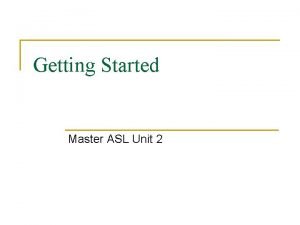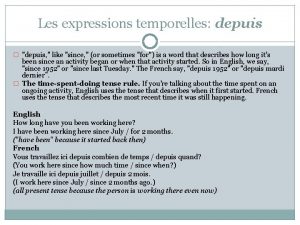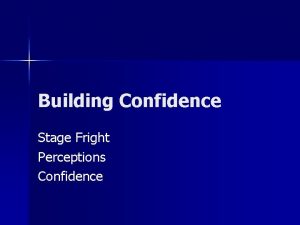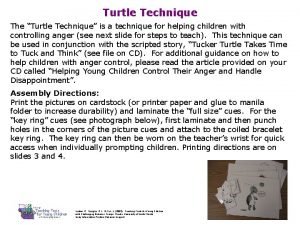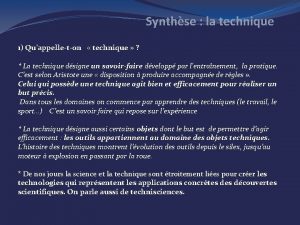A technique that will help you gain confidence
























- Slides: 24

A technique that will help you gain confidence!

� Why is charades considered improvisation? �You are working towards a goal. You are creating a way of expressing emotion without pre planning. You are communicating with the other people in the room using non verbal communication. � Piece of paper you will tear into thirds. � On each third of paper, PRINT the following: �The title of a TV show �The title of a book �The title of a movie

� Improvisation is the portrayal of a character or a scene without rehearsal or preparation. � You will make up: �The Character �The lines �The Action You will make these things up without a formal script. - The Key to Improvisation is IMAGINATION! -

� You must convey: � Personality � Physical Traits � Conflicts � Desires � Age Your Character must be conveyed by: - - - Voice - Body Language - Movement Illusion of the First Time – making the audience feel that each performance is the first.

Improvisation is the foundation or interpretation. � The Beginning performer usually wants to experience the actual emotion rather than to portray it. They want to feel sadness rather than portray sadness. There’s a difference. � Improvisation focuses your attention on NATURAL ACTIONS and REACTIONS! � Improvisation should force you to concentrate on IMMEDIATE RESPONSES. � All Actions should be motivated by: � � What you already know about the characters situation � What is brought forth as you improvise You must play the role as it develop. A Scene can change by a single line or action. You may have to do nothing and let the audience just know you are there. You don’t want to practice SCENE STEALING: diverting attention from the other actors to yourself.

� Character Centered Approach: �Focuses on a character or a group of characters who experience different situations on after another. This emphasizes each character’s response to those situations. � Situation �Takes Centered Approach: a single situation and places a number of characters in the situation to demonstrate how different personalities will respond to the same event. We get SITUATION COMEDIES from this, also knows as SIT COMS.

� The Mirror �Get a partner (one I will at random, one with friend) �Choose an activator and a responder. �One person activates motion, other responds. �Goal: Develop Concentration, Learn to work smoothly with a partner, Feel Single Impulse of Action �DO NOT – Try to trick your partner. Not the goal.

� The Machine �Group Improvisation �Puts your imagination to the test. �One person starts machine by performing physical action. �Another person joins the first piece of the machine by linking a different physical action to the first. �Others eventually join in. �VAR 1: Machine must turn something raw into something finished. �VAR 2: Add sounds to the actions. Each new actions must have it’s own sound.

� Beginning actors can work out scenes well. Things to remember are: �Work out your stage setting (Where are you etc) �Know where your entrances will be �Use actions to suggest entrances and major props. � As you turn the stage into different locations, you are also: �Developing your imagination along with the imaginations of the rest of the class. � The audience will: �See whatever you make clear through your explanation and your performance. � Visualize �Feel your character and try to: his or her emotions.

� Before you enter: �Take on the physical attitude of your character as dictated by the characters age, size, and mood. � Walk in character when you come on stage and be aware of the audience at all times!

� Speak loudly enough to be heard throughout theatre or auditorium. � Do not hide behind furniture, people, or props. � Move about freely. Try not to stand beside other characters all the time. � Take plenty of time to speak and to move so that you can create a definite impression. � Stay in character ALL the time. Listen and speak as your character would in every situation. Always exhibit actions and reactions that are appropriate for your character.

� Choose a simply action that you do all the time. There must be a sense of urgency to it. It needs to be an action that you can do without props or that you can pantomime. It’s ok if you don’t need to talk. Just enter, if you need to, do the action, and then leave, if you need to. � Ex/ Hemming a skirt, photographing a subject, changing a tire, applying make up, writing a letter, hiding a valuable. Variation 2 – add a second person into the scene. This person also has an action to perform. Neither of you, however, must be distracted by the other’s behavior. Variation 3 – Add conversation to the scene. Both of you continue to perform your actions. However, you now talk to each other or mutter to yourselves. Continue to concentration on the actions in spite of complication of talking.

� When skilled actors mirror people’s natural responses to internal or external stimuli – thoughts, actions, or what they hear, see, taste, feel or smell.

� You experience the stimuli. � You respond instinctively to the stimulus (Primary response) � The idea “connects. ” Your brain registers the stimulus – this usually takes only a fraction of a second. (Idea Connection) � If the stimulus is the kind that causes a reflex action, you might jerk back your head, or you might make a sound. Your eyes look in that direction. Then your body reacts; your chest moves in the direction of the stimulus (Secondary Response) � You react vocally and/or physically with your main response.

This whole sequence could happen in less than a second. � All steps must be present in order for the action to be believable. � EXAMPLE/ � � Early Morning School Day � You are asleep in Bed � The alarm goes off (stimulus) � You awaken (Primary Response) � Your brain tells you the alarm is going off (idea connection) � You think, “It’s Tuesday, school today” (idea connection) � You glare at the clock (secondary response) � “Yes, it’s really 6: 00 am. ” (idea connection) � You reach out and shut off the alarm clock (main response). If you follow a motivated sequence on stage, your actions will be believable to the audience. � When you have a script in your hand, you might jump to a response without following the sequence. � The audience might not see the performance as believable. �

� It is demanding for an inexperienced actor to: �Build a character �Work out a situation �Formulate Actions �Create effective dialogue � You must establish a character beforehand the words and the actions will come much more easily. � Ask questions and do research to help define your character. � Instead of a dozen sentences, these might convey more information about your character: �Raised eyebrow �Silent stare �One word response �Groan

� Applying the Motivated Sequence �Apply the given circumstances to the motivated sequence. You are preparing to enjoy a meal in a find restaurant. As you pick up your fork, you see a fly in your food. The Principal enters your classroom and in a serious voice asks you to accompany her to the office. You pick up the morning newspaper and read that a close friend has been selected for a prestigious award. Your history teacher announces a pop quiz on a chapter you have not read. Mr. Bulla chooses you to get in front of the class and perform your motivated sequence performance.

� Who am I? � What kind of person am I? � How am I different from the other characters? � What are the fewest things I can do to convey the most information about my character? � What does my character want? � In your characterization, don’t downplay the character. � Italian playwright Luigi Pirandello said that a person plays a Game of Masks in life, putting on a different mask for each person or occasion faced.

� We are going to reenact some event, real or imaginary. �At lunch someone rushes in with news that a spaceship has just landed in a nearby park. Speculate on the ship, its occupants, its origin, and so forth. �After having just been given an engagement ring, announce it to the world, including your former admirers and your fiance’s former admirers. �You are in a part and your significant other has gotten ice cream. You are walking a long and yours falls off the cone and their ice cream stays in place. Get the ice cream from him. �Can you think of another one?

� 10 Do’s of Improvisation �Quickly establish your character in your mind (age, occupation, physical and mental traits, and so on!) �Identify the problem and your goal by asking what your character wants or needs. �Keep focused on meeting your need or goal. �React spontaneously to what is said or done. �Let the situation provide the basis for how your character attempts to reach the goal. �See things through the eyes of your character. �Take your cues from your scene partner or partners. �Listen to and observe what others are saying and doing. �Play your scene from moment to moment. �Say or do things that demand a definite response.

� 4 Don’ts of Improvisation �Don’t deny anything your scene partners say about you or the situation. (STOP) If your partners say you have lovely yellow eyes, accept the statement as true, and use your imagination as you respond. �Don’t ask questions. Questions turn an improvisation into a question and answer routine. (STOP) Especially avoid “terminal questions, ” that can be answered with a yes or no or with a response that shuts down the flow of the dialogue. �Don’t use simple states of information. (STOP) Use descriptive language to make active statements about your feelings, observations, needs, and goals. �Don’t explain situations and feelings. (STOP) If you are happy, show it. If you are afraid of the dark, show it. Telling is storytelling, not acting. Acting is doing.

� With a partner, act out a scene of your own choosing. � Get ideas from photographs you know, newspaper clippings, cartoons, anecdotes from magazines, events in the lives of people you know, or historical and literary sources. Choose any type of scene – comic or sad, fanciful or realistic. Decide on the mood and the general idea you want to convey. Select the character you will play, each character should have a distinct personality. The greater the difference in age, personality, and type between the characters, the more contrast your scene will contain. � Form a group consisting of three females and two males to improvise the following scene: � It is 4: 30 PM. There are five people on an elevator: a film star on her way to a 4: 40 audition; a courier delivering an urgent legal brief; a professional athlete who is to be interviewed on the 5: 00 PM sportscast; a window washer headed for the 12 th floor to finish the last task of the day before leaving work to catch the 5: 12 uptown bus; a 13 year old going to see a parent on the 6 th floor. Just as the elevator leaves the third floor where the window washer got on, there is a power failure, stranding the passengers between floors. IMPROVISE!

� The teacher will assign you and your partner a simply location and a relationship. For example, the relationship could be between brother and sister and the location could b e the family's garage. One person is already in the garage engaged in an activity such as pumping up a bike tire. That person is in a certain mood. The second person arrives from a specific location and is in a specific mood. Act out your scene, building around your two moods, the relationship, and the location of the present action.

� It is harder to work by yourself than with other people. � By yourself you can take more time to create a personality and to show your character’s feelings more in depth. � Make sure to stay relaxed and have fun. � Do not allow yourself to feel embarrassed by the reactions of others. � Imagination is key. � Try different sorts of people and emotions at home to help bring your classwork more depth.
 Confidence interval vs confidence level
Confidence interval vs confidence level How to interpret confidence intervals example
How to interpret confidence intervals example Help us help you
Help us help you My mother makes me chicken
My mother makes me chicken N
N Phân độ lown
Phân độ lown Block nhĩ thất cấp 1
Block nhĩ thất cấp 1 Thơ thất ngôn tứ tuyệt đường luật
Thơ thất ngôn tứ tuyệt đường luật Thơ thất ngôn tứ tuyệt đường luật
Thơ thất ngôn tứ tuyệt đường luật Chiến lược kinh doanh quốc tế của walmart
Chiến lược kinh doanh quốc tế của walmart Tìm vết của mặt phẳng
Tìm vết của mặt phẳng Con hãy đưa tay khi thấy người vấp ngã
Con hãy đưa tay khi thấy người vấp ngã Tôn thất thuyết là ai
Tôn thất thuyết là ai Gây tê cơ vuông thắt lưng
Gây tê cơ vuông thắt lưng Sau thất bại ở hồ điển triệt
Sau thất bại ở hồ điển triệt Help help i'm being oppressed
Help help i'm being oppressed Helper chapter 1
Helper chapter 1 Self help and community help is the motto of
Self help and community help is the motto of Client handling task
Client handling task Reported speech will
Reported speech will Why are refusal skills important
Why are refusal skills important Les expressions temporelles
Les expressions temporelles Wish clause exercise
Wish clause exercise How church helps the community
How church helps the community Help your mother
Help your mother




